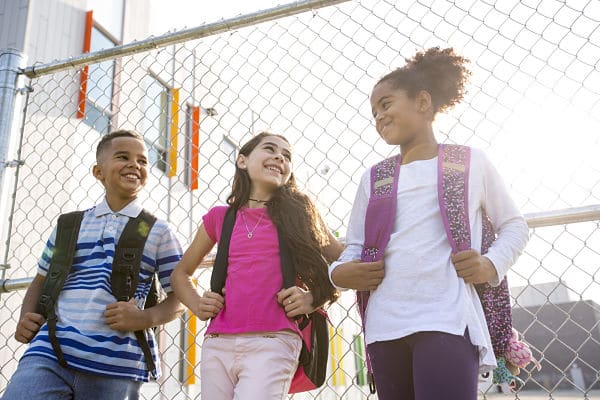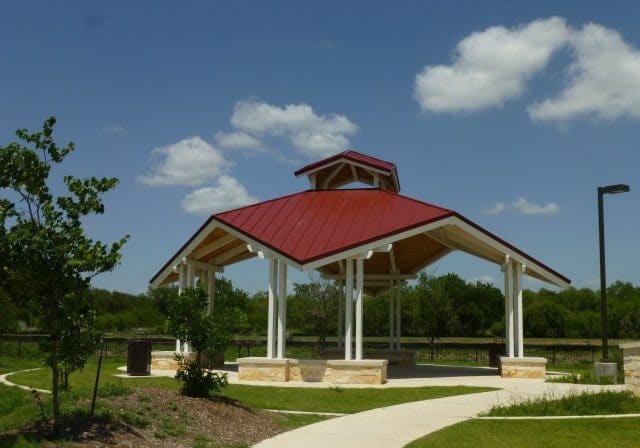If there is ever a year that your district’s students could use the mental peace, cognitive rebalancing and relative freedom that outdoor classrooms can provide, it has to be 2020. And it’s an idea that is gaining traction across the country. Green Schoolyards America (GSA) and their partners have organized a national COVID-19 Outdoor Learning Initiative around the idea of using campus grounds, parks and other outdoor areas as learning assets this fall.
If your district is considering development of outdoor classrooms at any campus or grade level – preschool and elementary on through high school — here are some points to keep in mind for the design and planning stages.
Designing Your Classrooms
Teaching and learning are served best when each classroom is designed for the specific needs of each campus, the surrounding neighborhood, and the available space. While the standard “outdoor classroom” is often built loosely around the concept of an amphitheater or a ring of seats, part of the design process is envisioning how the space will support the curriculum and other educational concepts.
Depending on existing amenities, a campus may not need a whole new development as much as a targeted renovation in order to create an outdoor classroom. Areas that are ripe for renovation include unused parking structures or lots, underutilized gardens and/or walking paths, bare courtyards, etc. Some campuses may have play areas or fenced areas that could be developed for multipurpose use. The question becomes, how can different elements of this space and our design support different roles throughout the day?
Around the country, outdoor spaces have already been designed to serve a variety of needs. For instance, an outdoor classroom can be a living science laboratory with storm water collection and garden zones; one class period later, a foreign-language class sends small groups throughout the enclosed space playing variations of “I Spy.” A stately old oak can be the source of inspiration in art class and the shade for reading class. Clipboards replace desks while students use pebbles and seeds as the starting point for math problems.
The Boston Schoolyard Initiative has developed a truly excellent resource for planning your outdoor classroom design. The guide lists many points to consider during the planning phase, including:
- What will the classroom’s entry point look like – will it be gated or open?
- How will teachers use the space – will they have the whole class meet at once, in one spot? Will there be teacher demonstrations? etc.
- How will students move through the space – will they work individually or in small groups? Will they sit, stand, or both?
- What materials will form the “floor” and “ceiling”?
- What kind of seating will be needed?
- What adaptations should be made to support the acoustics?
- How will the space accommodate accessibility requirements?
- How can you add even more flexibility to support different learning styles and different curricula?
As an additional consideration, planning for the maintenance of your outdoor classrooms is essential during the design process. Some daily maintenance tasks can be handled by students or classes as part of the educational process, but can other necessary procedures be handled by your maintenance or grounds crews? Will you need community support?

Selecting Materials
Any materials used in outdoor learning spaces should meet your district’s standard criteria for high educational value, low maintenance, sustainability and longevity. Some materials can be as simple as painted asphalt – but before selecting other materials, it will be important to consult with the professionals. Shade, for instance, is critical to any outdoor installation in Texas; you’ll need recommendations on which materials provide the most protection and hold up well over time. Surfacing will be another concern, particularly when meeting accessibility criteria. Even seemingly simple amenities like seating, picnic tables, and waste receptacles can vary widely in their cost-effectiveness, durability and appropriateness for your needs.
At Park Place Recreation, we’d like to point out that we’re part of your community too, and we’d love to help. We’ve been building creative, safe, long-wearing and cost-effective playgrounds and play spaces for organizations around South Texas for almost 40 years. We can work with any budget and are experienced in finding ways to meet the special requirements of every project. We’re a TXMAS-approved vendor and a member of the Buyboard, and we can provide a “Buy American” certificate for anyone purchasing equipment under the American Recovery & Reinvestment Act. Contact us today to speak with one of our experts about your outdoor classroom needs.
